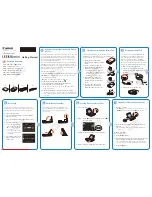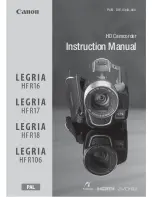
More than one sound source
The most typical example of this
is several people talking at the
same time. As the "director and
producer" of a sound movie, be
firm with your subjects, stop them
from doing it. Occasionally, a
rehearsal will be needed to estab-
li sh the order in which the subjects
will speak or the way they are to
conduct a conversation. What-
ever it takes, make sure that only
one person will talk at a time.
This, of course, does not apply in
a scene where several people
wish happy birthday at the same
ti me, and at similar occasions, but
the basic rule of clarity in sound
recording is that most of the time
only one person should be heard.
When due to circumstances more
than one sound source has to be
tolerated, place the microphone
close to the source to be recorded
and turn the audio gain control
to "L" (low).
Microphone placement
The microphone supplied with
the camera is omnidirectional: it
will pick up sounds coming from
all directions. This is desirable
when people gathered around the
microphone are to be heard, each
in its turn: the microphone will
pick up the speech of each person
with equal efficiency.
However, when one sound source
is to be favored over others, place
the microphone close to that
source, turned toward it, other-
wise sound from other sources
will interfere with the sound from
the selected source. If needed, a
unidirectional accessory micro-
phone can be used. The camera
will accept any microphone with
an impedance of 200 to 600 ohms.
The unidirectional mike favors
sounds coming from the direction
it is facing; its use can result in
cleaner recorded sound under
certain conditions.
Do not let people talk directly into
the microphone: it can result in a
hissing noise every time a sibilant
letter is pronounced. Place the
mike lower, pointed upward, and
have the subject talk over the top
of it, rather than into it.
Poor location
Not every place lends itself to
sound recording. Some rooms,
for example, with uncovered floor
and walls can create an echo that
results in garbled recordings.
Carpeted floors, drapes and so-
called acoustic ceilings tend to
absorb sound, rather than reflect
it, and usually result in cleaner
recording.
When monitoring with the ear-
phone shows that sound repro-
duction is poor in spite of the best
mike placement and other precau-
tions, it is better to change loca-
tion than produce a movie with
poor sound.
MORE TIPS
More than anything else, advance
planning can help you produce
sound movies of high quality. Plan
the image and the sound as a
unit, let one reinforce the effect of
the other. Make notes, then use
them as you set up each scene.
When you make movies of "sound-
less" subjects, such as scenery,
add sound in the form of narrative,
music, or both, using the record-
ing function of the sound
projector.
21




































